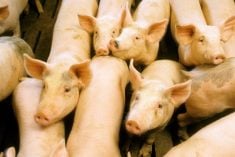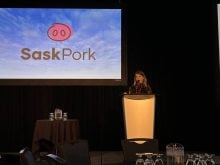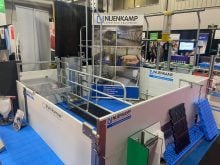Customers of Canadian swine genetics company Alliance Genetics Canada (AGC) will soon have more access to sire lines from the Danish hog industry through a new agreement that brings the Canadian company under the umbrella of the 120-year-old DanBred corporation.
DanBred Canada CEO Dave Vandenbroek says it’s a match of corporate values and also of low-key Canadian and Danish “personalities.” The companies announced the collaboration July 19.
AGC will come under the wing of the newly created DanBred Canada marketing brand, with corporate ownership residing at DanBred’s headquarters in Denmark.
Read Also

Dissolving eartags could make pig traceability easier
A dissolving eartag for market hogs, called Clean Trace could reduce processing challenges and enable more individual management of pigs.
Why it matters: Alliance Genetics was one of the last independently owned large swine genetics companies in Canada until a new collaboration was announced.
Vandenbroek, the only CEO that AGC has known since it formed in 2013, says the move ensures long-term profitability for nucleus herd partners and allows improved cost-effectiveness for AGC’s swine genetics customers.
When AGC was formed through partnership agreements with more than a dozen nucleus herds and nearly 10,000 purebred sows from Duroc, Landrace and Yorkshire lines, it drew on genetics developed over the previous 40 years in Ontario.
It now works with numerous nucleus and multiplier herds, including one in Alberta. According to Vandenbroek, in 2022 the company maintains “a good market share in selling F1 (crosses) here in Ontario and in Alberta, as well as a good market share for terminal (semen) products across Canada.”
However, company leadership knew a strong future would not be secured by the status quo.
“As an independent company, we did very well with the products and genetics that we developed,” Vandenbroek told Farmtario.
But with limited resources for conducting research and exploring global opportunities, it would be tough to maintain top-level product offerings.
“A company like DanBred is able to make genetic improvements in a more efficient and timely manner and we felt we weren’t going to be able to compete with that,” he said.
On the flip side, DanBred had established a nucleus herd in the United States more than a year ago and was looking for a further foothold in the North American market.
“We knew there was some interest for DanBred to come into Canada,” said Vandenbroek. Initial conversations took place in November 2021.
“Their options were either to work with someone with an established presence or to start from scratch. Their first choice was to work with existing clients … (and) it seemed evident right away that we could at least explore the idea.”
AGC’s nucleus and multiplier herds, and its terminal product customers, were top of mind as talks with DanBred progressed.
“We talked a lot about our breeding program and what our goals were, and it seemed to draw a lot of parallels to what (DanBred’s) are.”
A visit to DanBred’s facilities in Denmark was followed by explorations of how the Danish company’s genetics perform in other swine sectors, including in Europe, the U.S. and Brazil, where feeding and care regimens are similar to those in Canada.
Vandenbroek said he believes feed conversion efficiency will be increasingly important for Canadian hog producers.
“There’s a lot of reputable measurements behind these sire lines. If we didn’t think that our customers were going to be better served from this, we wouldn’t have done it.”
The Danish company’s July 19 news release says the AGC agreement “fits well with DanBred’s ambition to get even closer to its customers worldwide by increasing local market presence in all relevant markets. … The established customer base in Canada will gain from an even stronger research and development engine, while still interacting with the experts they already know from Alliance Genetics Canada.”
Lasse Bjørn, DanBred’s North American regional sales manager, said the two companies “share the same values, (for example) ensuring the largest profitability for the pig producers and a strong focus on high health and biosecurity.”













